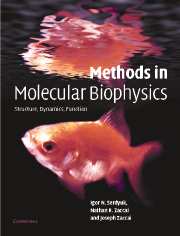Book contents
- Frontmatter
- Contents
- Foreword by D. M. Engelman
- Foreword by Pierre Joliot
- Preface
- Introduction: Molecular biophysics at the beginning of the twenty-first century: from ensemble measurements to single-molecule detection
- Part A Biological macromolecules and physical tools
- Part B Mass spectrometry
- Part C Thermodynamics
- Part D Hydrodynamics
- Part E Optical spectroscopy
- Part F Optical microscopy
- Chapter F1 Light microscopy
- Chapter F2 Atomic force microscopy
- Chapter F3 Fluorescence microscopy
- Chapter F4 Single-molecule detection
- Chapter F5 Single-molecule manipulation
- Part G X-ray and neutron diffraction
- Part H Electron diffraction
- Part I Molecular dynamics
- Part J Nuclear magnetic resonance
- References
- Index of eminent scientists
- Subject Index
- References
Chapter F3 - Fluorescence microscopy
from Part F - Optical microscopy
Published online by Cambridge University Press: 05 November 2012
- Frontmatter
- Contents
- Foreword by D. M. Engelman
- Foreword by Pierre Joliot
- Preface
- Introduction: Molecular biophysics at the beginning of the twenty-first century: from ensemble measurements to single-molecule detection
- Part A Biological macromolecules and physical tools
- Part B Mass spectrometry
- Part C Thermodynamics
- Part D Hydrodynamics
- Part E Optical spectroscopy
- Part F Optical microscopy
- Chapter F1 Light microscopy
- Chapter F2 Atomic force microscopy
- Chapter F3 Fluorescence microscopy
- Chapter F4 Single-molecule detection
- Chapter F5 Single-molecule manipulation
- Part G X-ray and neutron diffraction
- Part H Electron diffraction
- Part I Molecular dynamics
- Part J Nuclear magnetic resonance
- References
- Index of eminent scientists
- Subject Index
- References
Summary
Historical review
1931
M. Goppert-Mayer gave the theoretical background of two-photon excitation in fluorescence. Thirty years later this phenomenon was observed experimentally shortly after the invention of the laser by W. Kaiser and C. Garrett. In 1990 W. Denk introduced two-photon excitation in fluorescent microscopy.
1948
T. Forster formulated the principle of fluorescence resonance energy transfer (FRET), a phenomenon that occurs when two different chromophores (donor and acceptor) with overlapping emission/absorption spectra are separated by a suitable orientation and a distance in the range 20–100 Å. In the early 1970s, after a long period of inaction, the ground-breaking work of L. Stryer and R. P Hohland on FRET revealed the spatial proximity relationships of two fluorescence-labelled sites in biological macromolecules, thereby establishing FRET as a spectroscopic ruler. All of this early work used either fluorescent analogues of biomolecules or fluorescent reagents covalently or non-covalently attached to macromolecules as donors or acceptors of FRET. In the 1990s the introduction of the green fluorescent protein (GFP) to FRET-based imaging microscopy gave new life to its use as a sensitive probe of protein–protein interactions and protein conformational changes in vivo.
1964
S. Singh and L. Bradely predicted a three-photon absorption mechanism. In 1995 three-photon excited fluorescence spectroscopy and microscopy was demonstrated by a few groups and applied to the imaging of biological specimens and live cells.
Early 1970s
The first lifetime measurements on single points under a microscope were carried out by a few groups.
Information
- Type
- Chapter
- Information
- Methods in Molecular BiophysicsStructure, Dynamics, Function, pp. 658 - 682Publisher: Cambridge University PressPrint publication year: 2007
